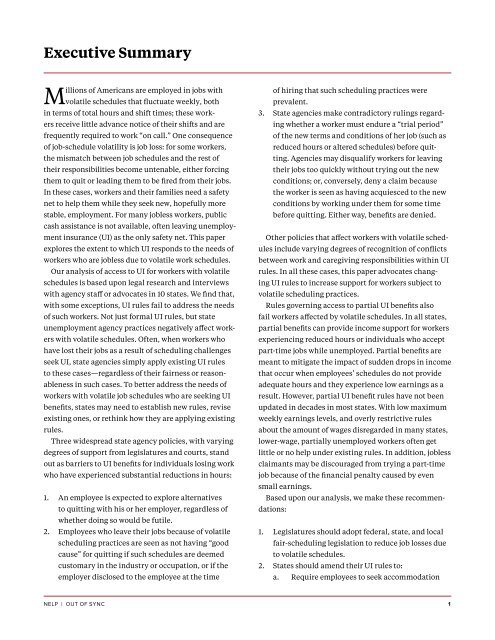Out of Sync
Out-of-Sync-Report
Out-of-Sync-Report
- No tags were found...
You also want an ePaper? Increase the reach of your titles
YUMPU automatically turns print PDFs into web optimized ePapers that Google loves.
Executive SummaryMillions <strong>of</strong> Americans are employed in jobs withvolatile schedules that fluctuate weekly, bothin terms <strong>of</strong> total hours and shift times; these workersreceive little advance notice <strong>of</strong> their shifts and arefrequently required to work “on call.” One consequence<strong>of</strong> job-schedule volatility is job loss: for some workers,the mismatch between job schedules and the rest <strong>of</strong>their responsibilities become untenable, either forcingthem to quit or leading them to be fired from their jobs.In these cases, workers and their families need a safetynet to help them while they seek new, hopefully morestable, employment. For many jobless workers, publiccash assistance is not available, <strong>of</strong>ten leaving unemploymentinsurance (UI) as the only safety net. This paperexplores the extent to which UI responds to the needs <strong>of</strong>workers who are jobless due to volatile work schedules.Our analysis <strong>of</strong> access to UI for workers with volatileschedules is based upon legal research and interviewswith agency staff or advocates in 10 states. We find that,with some exceptions, UI rules fail to address the needs<strong>of</strong> such workers. Not just formal UI rules, but stateunemployment agency practices negatively affect workerswith volatile schedules. Often, when workers whohave lost their jobs as a result <strong>of</strong> scheduling challengesseek UI, state agencies simply apply existing UI rulesto these cases—regardless <strong>of</strong> their fairness or reasonablenessin such cases. To better address the needs <strong>of</strong>workers with volatile job schedules who are seeking UIbenefits, states may need to establish new rules, reviseexisting ones, or rethink how they are applying existingrules.Three widespread state agency policies, with varyingdegrees <strong>of</strong> support from legislatures and courts, standout as barriers to UI benefits for individuals losing workwho have experienced substantial reductions in hours:1. An employee is expected to explore alternativesto quitting with his or her employer, regardless <strong>of</strong>whether doing so would be futile.2. Employees who leave their jobs because <strong>of</strong> volatilescheduling practices are seen as not having “goodcause” for quitting if such schedules are deemedcustomary in the industry or occupation, or if theemployer disclosed to the employee at the time<strong>of</strong> hiring that such scheduling practices wereprevalent.3. State agencies make contradictory rulings regardingwhether a worker must endure a “trial period”<strong>of</strong> the new terms and conditions <strong>of</strong> her job (such asreduced hours or altered schedules) before quitting.Agencies may disqualify workers for leavingtheir jobs too quickly without trying out the newconditions; or, conversely, deny a claim becausethe worker is seen as having acquiesced to the newconditions by working under them for some timebefore quitting. Either way, benefits are denied.Other policies that affect workers with volatile schedulesinclude varying degrees <strong>of</strong> recognition <strong>of</strong> conflictsbetween work and caregiving responsibilities within UIrules. In all these cases, this paper advocates changingUI rules to increase support for workers subject tovolatile scheduling practices.Rules governing access to partial UI benefits als<strong>of</strong>ail workers affected by volatile schedules. In all states,partial benefits can provide income support for workersexperiencing reduced hours or individuals who acceptpart-time jobs while unemployed. Partial benefits aremeant to mitigate the impact <strong>of</strong> sudden drops in incomethat occur when employees’ schedules do not provideadequate hours and they experience low earnings as aresult. However, partial UI benefit rules have not beenupdated in decades in most states. With low maximumweekly earnings levels, and overly restrictive rulesabout the amount <strong>of</strong> wages disregarded in many states,lower-wage, partially unemployed workers <strong>of</strong>ten getlittle or no help under existing rules. In addition, joblessclaimants may be discouraged from trying a part-timejob because <strong>of</strong> the financial penalty caused by evensmall earnings.Based upon our analysis, we make these recommendations:1. Legislatures should adopt federal, state, and localfair-scheduling legislation to reduce job losses dueto volatile schedules.2. States should amend their UI rules to:a. Require employees to seek accommodationNELP | OUT OF SYNC 1


